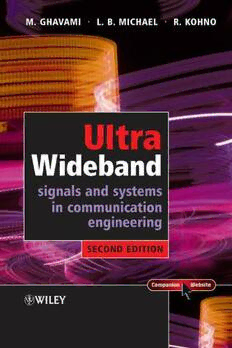
Ultra Wideband Signals and Systems in Communication Engineering PDF
Preview Ultra Wideband Signals and Systems in Communication Engineering
Ultra Wideband Signals and Systems in Communication Engineering Second Edition Ultra Wideband Signals and Systems in Communication Engineering Second Edition M. Ghavami King’s College London, UK L. B. Michael Japan R. Kohno Yokohama National University, Japan John Wiley & Sons, Ltd Copyright(cid:1)c 2007 JohnWiley&SonsLtd,TheAtrium,SouthernGate,Chichester, WestSussexPO198SQ,England Telephone (+44)1243779777 Email(forordersandcustomerserviceenquiries):[email protected] VisitourHomePageonwww.wiley.com AllRightsReserved.Nopartofthispublicationmaybereproduced,storedinaretrievalsystemor transmittedinanyformorbyanymeans,electronic, mechanical,photocopying, recording, scanningorotherwise,exceptunderthetermsoftheCopyright,DesignsandPatents Act1988or underthetermsofalicenceissuedbytheCopyrightLicensingAgencyLtd,90Tottenham Court Road,LondonW1T4LP,UK,withoutthepermissioninwritingofthePublisher.Requests tothe PublishershouldbeaddressedtothePermissionsDepartment,JohnWiley&SonsLtd,The Atrium,SouthernGate,Chichester,WestSussexPO198SQ,England,oremailedto [email protected],orfaxedto(+44)1243770620. Designations usedbycompaniestodistinguishtheirproductsareoftenclaimedastrademarks.All brandnamesandproductnamesusedinthisbookaretradenames,servicemarks,trademarksor registeredtrademarksoftheirrespectiveowners.ThePublisherisnotassociatedwithanyproduct orvendormentionedinthisbook. Thispublicationisdesignedtoprovideaccurateandauthoritative informationinregardtothe subjectmattercovered. ItissoldontheunderstandingthatthePublisherisnotengagedin renderingprofessionalservices.Ifprofessionaladviceorotherexpertassistanceisrequired,the servicesofacompetent professionalshouldbesought. Other Wiley Editorial Offices JohnWiley&SonsInc.,111RiverStreet, Hoboken,NJ07030,USA Jossey-Bass,989MarketStreet,SanFrancisco,CA94103-1741, USA Wiley-VCHVerlagGmbH,Boschstr.12,D-69469Weinheim,Germany JohnWiley&SonsAustraliaLtd,42McDougallStreet,Milton,Queensland4064,Australia JohnWiley&Sons(Asia)PteLtd,2ClementiLoop#02-01,JinXingDistripark,Singapore129809 JohnWiley&SonsCanadaLtd,6045FreemontBlvd,Mississauga,ONT,L5R4J3,Canada Wileyalsopublishesitsbooksinavarietyofelectronicformats.Somecontentthatappearsinprint maynotbeavailableinelectronicbooks. British Library Cataloguing in Publication Data AcataloguerecordforthisbookisavailablefromtheBritishLibrary ISBN978-0-470-02763-9(HB) TypesetbySunriseSettingLtd,Torquay,Devon,UK. PrintedandboundinGreatBritainbyAntonyRoweLtd,Chippenham,England. Thisbookisprintedonacid-freepaperresponsiblymanufacturedfromsustainableforestryinwhich atleasttwotreesareplantedforeachoneusedforpaperproduction. Contents Preface xiii Acknowledgments xvii List of Figures xix List of Tables xxix Introduction 1 I.1 Ultra wideband overview 1 I.2 A note on terminology 2 I.3 Historical development of UWB 2 I.4 UWB regulation overview 3 I.4.1 Basic definitions and rules 4 I.5 Key benefits of UWB 5 I.6 UWB and Shannon’s theory 6 I.7 Challenges for UWB 7 I.8 Summary 7 1 Basic properties of UWB signals and systems 9 1.1 Introduction 9 1.2 Power spectral density 10 1.3 Pulse shape 11 vi CONTENTS 1.4 Pulse trains 14 1.5 Spectral masks 16 1.6 Multipath 17 1.7 Penetration characteristics 20 1.8 Spatial and spectral capacities 20 1.9 Speed of data transmission 21 1.10 Cost 22 1.11 Size 22 1.12 Power consumption 23 1.13 Summary 23 2 Generation of UWB waveforms 25 2.1 Introduction 25 2.1.1 Damped sine waves 26 2.2 Gaussian waveforms 28 2.3 Designing waveforms for specific spectral masks 31 2.3.1 Introduction 32 2.3.2 Multiband modulation 33 2.4 Practical constraints and effects of imperfections 39 2.5 Summary 40 3 Signal-processing techniques for UWB systems 43 3.1 The effects of a lossy medium on a UWB transmitted signal 43 3.2 Time domain analysis 46 3.2.1 Classification of signals 46 3.2.2 Some useful functions 48 3.2.3 Some useful operations 51 3.2.4 Classification of systems 54 3.2.5 Impulse response 57 3.2.6 Distortionless transmission 57 3.3 Frequency domain techniques 57 3.3.1 Fourier transforms 57 3.3.2 Frequency response approaches 58 3.3.3 Transfer function 60 3.3.4 Laplace transform 63 3.3.5 z-transform 64 3.3.6 The relationship between the Laplace transform, the Fourier transform, and the z-transform 67 CONTENTS vii 3.4 UWB signal-processing issues and algorithms 68 3.5 Detection and amplification 71 3.6 Summary 72 4 UWB channel modeling 75 4.1 A simplified UWB multipath channel model 76 4.1.1 Number of resolvable multipath components 78 4.1.2 Multipath delay spread 78 4.1.3 Multipath intensity profile 79 4.1.4 Multipath amplitude-fading distribution 80 4.1.5 Multipath arrival times 81 4.2 Path loss model 83 4.2.1 Free space loss 83 4.2.2 Refraction 84 4.2.3 Reflection 84 4.2.4 Diffraction 85 4.2.5 Wave clutter 85 4.2.6 Aperture–medium coupling loss 85 4.2.7 Absorption 85 4.2.8 Example of free space path loss model 85 4.3 Two-ray UWB propagation model 87 4.3.1 Two-ray path loss 88 4.3.2 Two-ray path loss model 91 4.3.3 Impact of path loss frequency selectivity on UWB transmission 93 4.4 Frequency domain autoregressive model 96 4.4.1 Poles of the AR model 99 4.5 IEEE proposals for UWB channel models 100 4.5.1 An analytical description of the IEEE UWB indoor channel model 101 4.6 Summary 106 5 UWB communications 109 5.1 Introduction 109 5.2 UWB modulation methods 110 5.2.1 PPM 111 5.2.2 BPM 112 5.3 Other modulation methods 113 5.3.1 OPM 115 viii CONTENTS 5.3.2 PAM 115 5.3.3 OOK 116 5.3.4 Summary of UWB modulation methods 116 5.4 Pulse trains 116 5.4.1 Gaussian pulse train 117 5.4.2 PN channel coding 117 5.4.3 Time-hopping PPM UWB system 119 5.5 UWB transmitter 120 5.6 UWB receiver 121 5.6.1 Detection 122 5.6.2 Pulse integration 123 5.6.3 Tracking 123 5.6.4 Rake receivers 123 5.7 Multiple access techniques in UWB 123 5.7.1 Frequency division multiple access UWB 124 5.7.2 Time division multiple access 124 5.7.3 Code division multiple access 124 5.7.4 Orthogonal pulse multiple access system 124 5.8 Capacity of UWB systems 125 5.9 Comparison of UWB with other wideband communication systems 128 5.9.1 CDMA 130 5.9.2 Comparison of UWB with DSSS and FHSS 130 5.9.3 OFDM 133 5.10 Interference and coexistence of UWB with other systems 136 5.10.1 WLANs 137 5.10.2 Bluetooth 139 5.10.3 GPS 140 5.10.4 Cellular systems 141 5.10.5 Wi-Max 141 5.10.6 The effect of narrowband interference on UWB systems 143 5.11 Summary 146 6 Advanced UWB pulse generation 149 6.1 Hermite pulses 149 6.1.1 Hermite polynomials 150 6.1.2 Orthogonal modified Hermite pulses 151 CONTENTS ix 6.1.3 Modulated and modified Hermite pulses 154 6.2 Orthogonal prolate spheroidal wave functions 156 6.2.1 Introduction 157 6.2.2 Fundamentals of PSWFs 158 6.2.3 PSWF pulse generator 161 6.3 Wavelet packets in UWB PSM 166 6.3.1 PSM system model 168 6.3.2 Receiver structure 169 6.4 Summary 170 7 UWB antennas and arrays 173 7.1 Antenna fundamentals 174 7.1.1 Maxwell’s equations for free space 174 7.1.2 Wavelength 176 7.1.3 Antenna duality 176 7.1.4 Impedance matching 176 7.1.5 Voltage standing wave ratio and reflected power 177 7.1.6 Antenna bandwidth 177 7.1.7 Directivity and gain 177 7.1.8 Antenna field regions 178 7.1.9 Antenna directional pattern 178 7.1.10 Beamwidth 180 7.2 Antenna radiation for UWB signals 180 7.2.1 Dispersion due to near-field effects 183 7.3 Suitability of conventional antennas for the UWB system 184 7.3.1 Resonant antennas 184 7.3.2 Nonresonant antennas 187 7.3.3 Difficulties with UWB antenna design 187 7.4 Impulse antennas 188 7.4.1 Conical antenna 188 7.4.2 Monopole antenna 189 7.4.3 D-dot probe antenna 190 7.4.4 TEM horn antenna 190 7.4.5 Small-size UWB antenna 191 7.4.6 Conclusion 192
